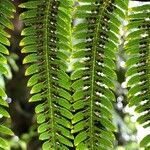Rhizome prostrate, stout, densely covered with shiny brown long hairs. Stipes thick, up to 1 m or more, triangular in transverse section at base, with dense caducous appressed hairs, stipe and rachis green, turning purplish abaxially with age, stipe with a continuous or broken row of linear aerophores on each side, base with a mass of long (1-1.5 cm) hairs, upper part of stipe and rachis covered with small, appressed flaccid hairs becoming glabrescent; lamina 2-pinnate-pinnatifid, 1.5-3 m; medial pinnae 40-80 × 15-30 cm, lower pinnae shortened, deflexed; pinnae many, alternate, stalked, pinnules shortly stalked, usually of ± equal length on either side of rachilla; pinnule segments slightly falcate, apiculate, margins crenulate to serrulate-serrate; veins free, fertile ones simple, sterile simple or forked; lamina subleathery, adaxial surface deep green, abaxial surface glaucous, glabrous on both sides, except hairy on midrib; venation visible on both surfaces, free, lateral veins simple or forked. Sori usually 1-5 at base of lower pairs of pinnule segments; indusia bivalvate, outer indusia orbicular, inner ones ± oblong; outer valve of indusium usually large; paraphyses dark reddish brown. Spores pale yellowish, with equatorial flange.
More
Caudex usually prostrate; hairs near apex shining, brown, to 4 cm or more long. Stipes to at least 120 cm, base densely hairy, rest smooth when old, softly short-hairy when young. Lamina to 200 cm long; longest pinnae 80 cm long. Largest pinnules 150 by 20-35 mm, lobed almost to the costa, often with 1-2 pairs offree tertiary leaflets at the base; costules 3.5-4.5 mm apart; segments of lamina glaucous beneath, edges where sterile crenate-serrate; lower surface of costae and costules more or less densely covered with pale entangled flaccid appressed hairs (young plants softly hairy throughout); veins oblique, usually forked, in largest pinnules sometimes twice forked. Sori 2-4 or more pairs on largest fronds, at the ends of lower veins on each lobe of the lamina, soriferous veins usually unbranched; receptacle rather oblique to the end of the vein so that it is parallel to the edge of the lobe; outer indusium permanently round, inner elongating at maturity and more or less oblong.
A tree fern. It lies along the ground or can be erect. It has long yellow hairs over the tips. The fronds are twice divided and have hairs at their base.
Amongst non-calcareous rocks and on steep ground in mountain forest, from near sealevel to 1600 m, in the Malay Peninsula and Sumatra; in Java only known from Mt Slamat at 1600 m. I have seen young plants of this species growing on a bare earth bank in a rather open place, above a path recently cut through forest on a mountain slope; perhaps in nature the species chiefly spreads by the establishment of new plants on land-slides. A specimen from Fraser's Hill (E. Smith 802) bears the note "frond 4 m, [incl.] stipe 2 m". Young plants are soft-hairy all over.
More
It is a tropical and subtropical plant. In southern China it grows between 200-600 m above sea level but can be at higher altitudes. It grows on open hill slopes and near streams between 500-1,600 m above sea level. In XTBG Yunnan.
Hillsides, gullies and forests, where it is shady and damp. Open places in forests, forest margins, valleys, warm humid environments; usually at elevations below 600 metres, occasionally to 1,600 metres.
Hillsides, gullies and forests, where it is shady and damp.
Uses. The hairs on the rhizome of this species of Cibotium (probably also of other species) have long been used in China as a styptic for bleeding wounds, and they have also been so used by various peoples in Malaysia; for details, see Heyne and Burkill. The common trade-name for these hairs seems to be Penawar (D)jambi. Cibotium hairs have also been used for stuffing cushions and for upholstery, but it is reported that they are not very satisfactory for this purpose.
More
The starch in the rhizomes is used in cakes and also to make liqueur.

